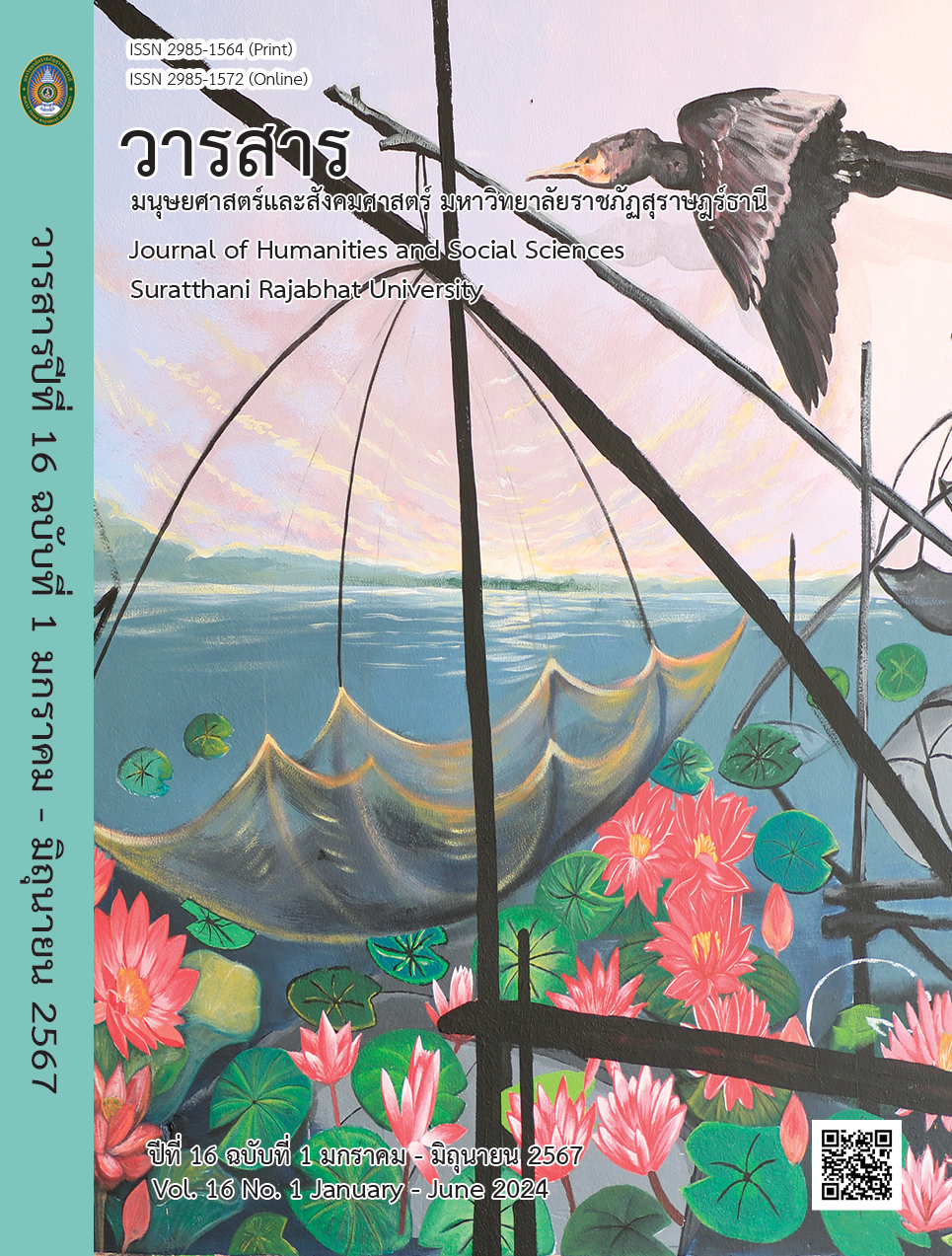The Comparison of Factors Affecting Self-Concept According to the Role of Military Cadets
Main Article Content
Abstract
This research applied a mixed-method approach to 1) study
self-concept according to the role of military cadets and 2) compare the personal factors that affect these self-concepts. Seventeen cadets in
command positions were chosen as key informants by purposive sampling. Following stratified random sampling, 60 cadets were chosen from the first to fifth years each in the 2021 academic year, resulting in 300 participants. The research instruments included a brainstorming activity worksheet and the test of the self-concept scale, which had a reliability of 0.965. The data was analyzed by frequency, percentage, mean, standard deviation, one-way analysis of variance (One-way ANOVA), and analytic induction.
This research found that: 1) overall self-concept according to
cadets' role is high, and 2) the comparison of the personal factors of the self-concept according to the role of cadets in differences in the cadet year, the reason for choosing to become a cadet, the expectation of average
academic performance in military subjects, and perception of being a
military student caused the difference in the statistical significance level at .01(p<0.01), and expectation of average grade academic caused the
difference in the statistical significance level at .05 (p<0.05). The research results will benefit military academies and personnel involved in enhancing self-concept and the self-concept audit system according to the role of
being a cadet before graduating as a commissioned officer with the desirable characteristics of the Royal Thai Army.
Article Details

This work is licensed under a Creative Commons Attribution-NonCommercial-NoDerivatives 4.0 International License.
All published manuscripts have been verified by peer-peer professors in the fields of humanities and social sciences. Reprinting of the article must be authorized by the editorial staff.
References
กรมนักเรียนนายร้อยรักษาพระองค์ โรงเรียนนายร้อยพระจุลจอมเกล้า [กรม นนร.รอ.รร.
จปร.]. (2565). คู่มือนักเรียนนายร้อย พ.ศ. 2565. กรุงเทพฯ: อรุณการพิมพ์.
กระทรวงศึกษาธิการ. (2553). พระราชบัญญัติการศึกษาแห่งชาติ พ.ศ. 2542 และที่แก้ไข
เพิ่มเติม (ฉบับที่ 2) พ.ศ. 2545 และ (ฉบับที่ 3) พ.ศ. 2553. กรุงเทพฯ: องค์การ
รับส่งสินค้าและพัสดุภัณฑ์.
กองทัพบก. (2564, 14 ตุลาคม). คำสั่งกองทัพบกที่ 66/2564 เรื่อง นโยบายการฝึกอบรม
และการศึกษาของกองทัพบก พ.ศ. 2565. กรุงเทพฯ: กรมยุทธศึกษาทหารบก.
ณัฐวุฒิ คิดควร, อวยพร ตั้งธงชัย, และ พรเทพ ราชรุจิทอง. (2564). อัตมโนทัศน์ของนิสิต
สาขาวิชาพลศึกษา ภาควิชาพลศึกษา คณะศึกษาศาสตร์ มหาวิทยาลัย
เกษตรศาสตร์. วารสารสุขศึกษา พลศึกษา และสันทนาการ, 47(1), 211-221.
บุญชม ศรีสะอาด. (2560). การวิจัยเบื้องต้น (พิมพ์ครั้งที่ 10). กรุงเทพฯ: สุวีริยาสาส์น.
พงศธร ภู่ทองคำ, และ งามลมัย ผิวเหลือง. (2562). อัตมโนทัศน์ การทำหน้าที่ของ
ครอบครัว การสนับสนุนทางสังคมและการสำนึกดีของนิสิต มหาวิทยาลัย
เกษตรศาสตร์ วิทยาเขตบางเขน. วารสารครุศาสตร์อุตสาหกรรม, 18(3), 272-
รุ่งอรุณ วัฒยากร. (2557). การศึกษาภาวะสุขภาพจิตของนักเรียนนายร้อย ชั้นปีที่ 1 ปีการ
ศึกษา 2556 โรงเรียนนายร้อยพระจุลจอมเกล้า. วารสารวิชาการมนุษยศาสตร์
และสังคมศาสตร์ โรงเรียนนายร้อยพระจุลจอมเกล้า, 1(1), 67-90.
รุ่งอรุณ วัฒยากร. (2561). ปัจจัยที่ส่งผลและแนวทางการส่งเสริมการปรับตัวของนักเรียน
นายร้อยใหม่ โรงเรียนนายร้อยพระจุลจอมเกล้า. วารสารวิชาการมนุษยศาสตร์
และสังคมศาสตร์ โรงเรียนนายร้อยพระจุลจอมเกล้า, 5(1), 209-242.
รุ่งอรุณ วัฒยากร. (2563). ความสามารถในการบริหารเวลาของนักเรียนนายร้อย โรงเรียน
นายร้อยพระจุลจอมเกล้า. วารสารวิชาการมนุษยศาสตร์และสังคมศาสตร์
โรงเรียนนายร้อยพระจุลจอมเกล้า, 7(1), 51-63.
รุ่งอรุณ วัฒยากร. (2565). คุณลักษณะผู้นำที่พึงประสงค์ของนักเรียนนายร้อย โรงเรียน
นายร้อยพระจุลจอมเกล้า. วารสารวิชาการมนุษยศาสตร์และสังคมศาสตร์
โรงเรียนนายร้อยพระจุลจอมเกล้า, 9(1), 95-109.
วรวุฒิ แสงทอง, และ วิรัช วิรัชนิภาวรรณ. (2561). การบริหารจัดการเพื่อเสริมสร้าง
คุณลักษณะผู้นำของนักเรียนนายร้อย โรงเรียนนายร้อยพระจุลจอมเกล้า.
วารสารวิชาการมหาวิทยาลัยอีสเทิร์นเอเชีย ฉบับสังคมศาสตร์และ
มนุษยศาสตร์, 8(3), 251-263.
ศรีเรือน แก้วกังวาล. (2561). ทฤษฎีจิตวิทยาบุคลิกภาพ (พิมพ์ครั้งที่ 15). กรุงเทพฯ: หมอ
ชาวบ้าน.
สินาพร วิทยาวนิชชัย, อรพินทร์ ชูชม, และ อัจศรา ประเสริฐสิน. (2562). การศึกษาอัต
ลักษณ์แห่งตนและอัตลักษณ์ทางวิชาชีพของนักศึกษาพยาบาล. วารสารบัณฑิต
ศึกษา มหาวิทยาลัยราชภัฏวไลยอลงกรณ์ ในพระบรมราชูปถัมภ์, 13(3), 125-
อนันต์ชัย คงจันทร์. (2558). การจัดการทรัพยากรมนุษย์ (พิมพ์ครั้งที่ 2). กรุงเทพฯ: สำนัก
พิมพ์แห่งจุฬาลงกรณ์มหาวิทยาลัย.
อัญชลี จันทร์เสม, นันทนา วงษ์ไทย, สุภัทรา วงสกุล, และ ปุญญิสา ยงศรีปัญญะฤทธิ์.
(2563). แนวคิดอัตมโนทัศน์กับการประยุกต์. วารสารมนุษยศาสตร์ปริทรรศน์,
(1), 55-67.
Allport, G. W. (1961). Pattern and growth in personality. New York: Holt, rinehart
& winston.
Craven, R. G., & Marsh, H. W. (2008). The centrality of the self-concept
construct for psychological wellbeing and unlocking human potential:
implications for child and educational psychologists. Educational
and Child Psychology, 25(2), 104-118.
Khalaila, R. (2015). The relationship between academic self concept, intrinsic
motivation, test anxiety, and academic achievement among nursing
students: Mediating and moderating effects. Nurse Education
Today, 35(3), 432–438.


